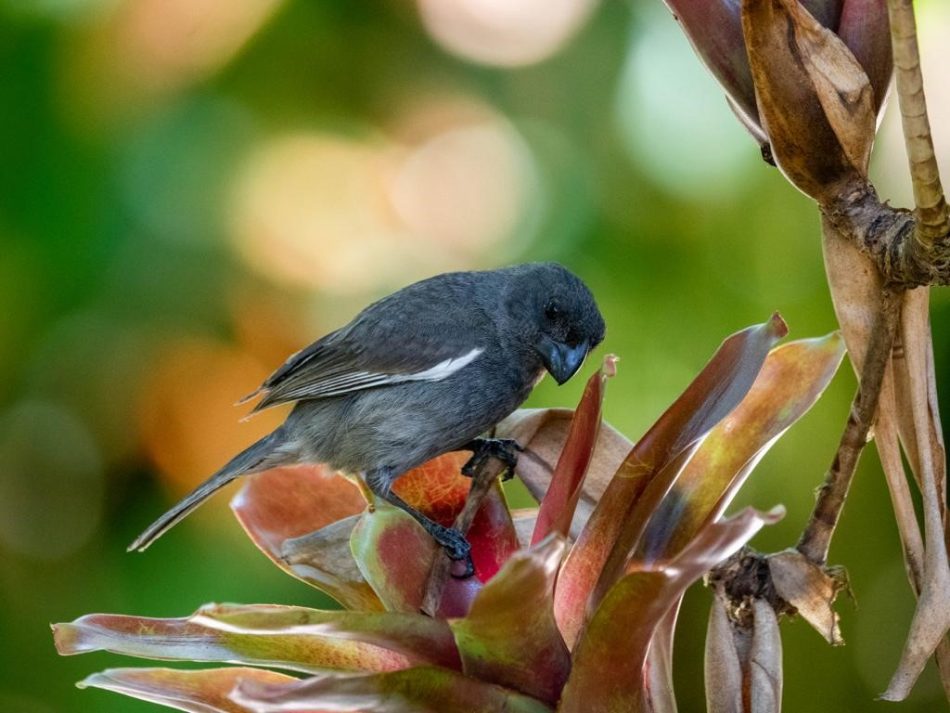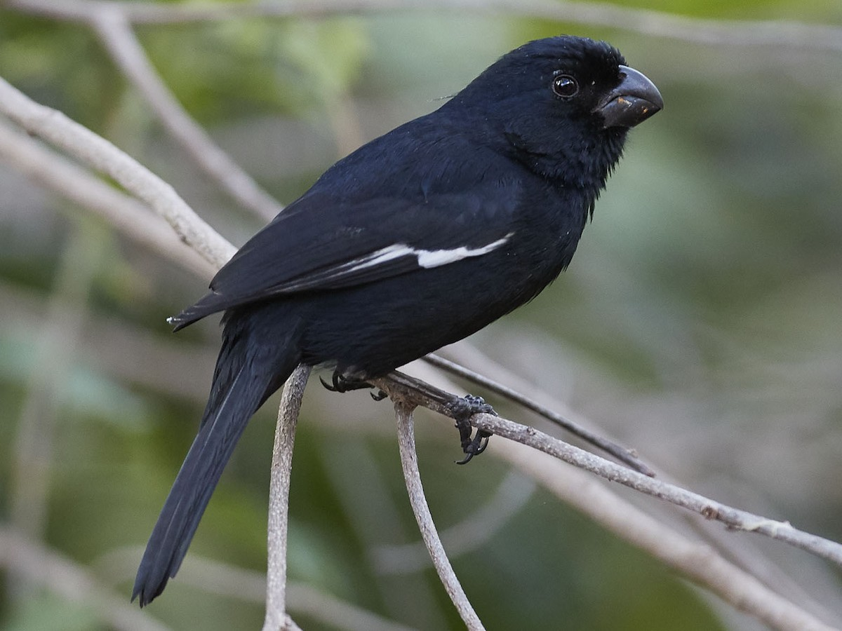The Grand Cayman Bullfinch: local bird now awarded full endemic species status
By Patricia E. Bradley

26th July 2023 – Introducing Melopyrrha taylori the Grand Cayman Bullfinch, an exciting addition to the Cayman Islands’ bird list, an endemic, and one of only two species in this monotypic West Indian genus.
This month the American Ornithological Society announced that the species Cuban Bullfinch Melopyrrha nigra, previously recognized as two endemic subspecies on Cuba and Grand Cayman, has been split into two endemic species, the Grand Cayman Bullfinch Melopyrrha taylori on Grand Cayman, Cayman Islands and the Cuban Bullfinch Melopyrrha nigra on Cuba. The decision was a belated response to an ornithological paper submitted in 2014 by four authors from Cuba and two from the Cayman Islands.* The endemic split had already been recognized by other world Ornithological Councils. The Grand Cayman Thrush, the only other modern endemic bird, was last seen in 1938 and is now considered extinct.
In modern times, the bullfinch on the Cayman Islands is of restricted range occurring only on Grand Cayman. Up to the 1980s, it was widespread throughout the island but intense development in the western half of Grand Cayman has since resulted in a species shift eastward and it now occurs almost exclusively east of Newlands. In the 1970s, Gary Morgan identified fossil bones of this species from circa 13,000 BP from caves on Cayman Brac.
The bullfinch was first collected on Grand Cayman for museums on 12 August 1886 by W.B Richardson for ornithologist Charles B Cory. He identified it as Melopyrrha nigra, the same species that occurred on Cuba. In 1886, Charles B Taylor collected bird specimens on Grand Cayman between 14 March-21 April 1896 for Lord Rothschild’s museum at Tring, England and where the bird specimens of the British Museum are now housed. Dr Hartert, the Director at Tring, declared the bullfinch a new species and named it M. taylori in 1896. Later, especially under ornithologist James Bond it reverted to two subspecies.

Both sexes of our bullfinch are morphologically distinct from the Cuban being larger, longer, heavier and with a larger, wider and deeper bill. Colouration differs with the dull black of the Cayman male as opposed to the glossy black with violet sheen of the Cuban. Both species have white on the underwing and on outer primaries showing as a white bar on the closed wing. The Cayman female is bi-coloured, blackish upperparts with brownish-olive grey underparts while the Cuban females is slate-blackish overall. Vocalisations are also distinctly different, with the Cuban song more complex.
Cayman birds build large bulky globular nests, often in a tangle of vines, woven with fibres, grasses, rootlets and twigs and lined with feathers; the entrance at the side. Preferred trees are Silver Thatch and two species of Shake Hand. Both adults build the nest and feed the young; only the female broods, 2-4 dull greenish white eggs with reddish spotting. The nest is also used for roosting post-breeding.
The bullfinch forages predominately on seeds and fruits throughout most habitats; it breeds preferably in dry shrubland and dry woodland, occasionally in forest and buttonwood -mangrove edge. However breeding has not been recorded in mangrove forest or in coastal seagrape hedge.
As a single island endemic of restricted range, the bullfinch is likely to be reclassified on the IUCN endangered species Red List to a Near-Threatened species of Global Concern. It will require monitoring by the DOE to ensure that as development encroaches into its eastern habitats sufficient areas are protected and remain connected to allow continued genetic diversity.
The Cayman Islands have 16 endemic subspecies, of these the Cuban Parrot has two subspecies, one on Grand Cayman and one on Cayman Brac. It is a likely candidate for genetic study to determine if either or both subspecies are sufficiently different from those on Cuba and the Bahamas to warrant separate endemic species designation.
Having an endemic bird is important – giving us a new flagship species to promote Cayman ‘s international biodiversity status and, locally, in education, tourism and the necessity of protecting wildlife habitat.
*Garrido, O. H., Wiley, J.W., Kirkconnell, A., Bradley P.E., Gunther-Calhoun, A. & Rodriguez, D. 2014. Revision of the Genus Melopyrrha from Cuba and the Cayman Islands. Bull.of Britiah Ornithologists’Club 134: 120-128.
IMAGES: Cayman Bullfinch – Tonya Wight
END
About the National Trust for the Cayman Islands
The National Trust for the Cayman Islands is a non-governmental organization whose mandate under the National Trust Law (2010 Revision) includes the preservation of the historic, natural and maritime heritage of the Cayman Islands for present and future generations.
About the Blue Iguana Conservation Programme
The Blue Iguana Recovery Programme began in 1990 with only 30 dedicated Blue Iguanas and the primary goal to restore the wild population to 1,000 Blue Iguanas, encouraging viable population in the long-term. Having met its primary goal in 2018, the initiative formally transitioned to the Blue Iguana Conservation Programme in 2019 with a new focus of sustainably conserving the native species of Grand Cayman.
About the National Trust’s Environmental Programme
The National Trust for the Cayman Islands’ environmental programme was founded on the concept that the protection of native plants and animals is best achieved by protecting the natural areas in which they depend.
About the National Trust Conservation Programme
The National Trust for the Cayman Islands’ conservation programme strives to protect Cayman’s native species and the habitats in which they live, and includes the endemic Blue Iguana of Grand Cayman, the Sister Islands Rock Iguana and Cayman’s native bat species.
About the National Trust Historic Preservation Programme
The National Trust for the Cayman Islands introduced the launching of its Historic Preservation Fund at its Annual General Meeting in September 2021 for the purpose of inviting increased support of its continuing efforts to encourage the preservation and protection of historic homes and buildings for present and future generations of the Cayman Islands.





